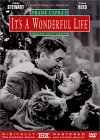It’s a Wonderful Life (1946)
 |
IT’S A WONDERFUL LIFE
Review by Noel Wood |

#2 on our list of the Best Christmas Movies Ever!
Most people, when recalling Christmas movies, tend to rattle off IT’S A WONDERFUL LIFE as the one that immediately springs to mind. Not that there’s any problem with that. This film was one of the very first important films to have a Christmas theme to it, and it is a film that almost everyone has seen due to its massive exposure on television in the last several years. On top of that, it’s a movie that is truly timeless, and holds up as a great film to this day.
First, a side note about this film, that I found interesting when I recently learned it. The reason why this film is seemingly omnipresent around the holidays on amlost every television station imaginable is due to the fact that the original version is no longer copyrighted. Therefore, anyone who wants to can show this movie for without having to pay for the rights. An interesting thing about that fact is that Ted “Satan Himself” Turner decided some time ago, while in his quest to rape the world of all that is pure and holy, to make a colorized version of the movie. For those who weren’t around when this was actually going on, Turner felt it necessary at one point to take classic black-and-white films, that had been enjoyed for decades in their beautiful purity by multiple generations, and use a computerized process to change them into color movies. The result was this horrible cartoonish color palatte that did more to distract from the way the movie looked than enhance it at all. But here’s the irony of this all: The colorized version is copyrighted, so in order for someone to get the rights of the far inferior version of the film, they have to shell out big bucks. Since the world finally came to its senses a few years back and decided that colorization is the work of the devil, nobody pays the money, and just grabs the free original version. Can’t say I blame them.
Many people will also tell you that this is the greatest Christmas movie of all time. And they’d not be far off, at least according to my little list here, which you know you should hold to as the gospel truth anyway. The movie just barely misses the mark for a couple of reasons, but one of the most important reasons is actually in the film’s favor: When you think about it, it’s really not as much of a Christmas movie as you would think. Now I know I made a big stink about what defined a Christmas movie earlier, but the “debatable” ones I listed all were set in a timeframe that was wholly within the holiday season. DIE HARD, GREMLINS, THE REF…all take place completely at that time. IT’S A WONDERFUL LIFE, however, takes place over many years, and through all sorts of seasons. In fact, it isn’t until the first hour and ten minutes or so of backstory gets finished that it even turns in to a Christmas setting. However, this is the portion of the movie that most people recall, because it’s where the significant message takes place.
This case signifies why this is such a brilliant film: The structure of IT’S A WONDERFUL LIFE is so simplistically brilliant, that you have to stop and wonder just why filmmakers never do anything remotely like theis anymore. You see, Frank Capra did something almost unheard of in today’s cinema: He spent an entire hour just establishing the character of our protagonist, George Bailey. Can you imagine a filmmaker doing that today, at least in a film that actually had a story to go along with it? Can you imagine an audience’s reaction if they sat down to see the latest Hollywood Blockbuster, and they had to endure an hour-long character study of the hero ahead of time? It would likely incite a riot. And I’m not talking a character study along the likes of JERRY MAGUIRE, I’m talking a film that actually has some sort of plot and story. But that’s what’s done here, and its part of the reason why the film works.
Again, we meet George Bailey, through the aid of some angels in heaven, represented only by some very low-tech graphics of twinkling stars. Apparently, he’s in a crisis, so they send an angel named Clarence down to turn him around. As a prize for his success, Clarence will earn his wings. Now it would be just as easy to go from this point right into the action, but instead, Capra takes us back to the beginning, through all the important trials of George’s life. He saves his brother’s life as a child, he sacrifices his ambitions to take over for his father’s Buiding and Loan company, he meets — and remeets — and meets again, the girl who would be the love of his life. We’ve thoroughly been introduced to George, so when it actually gets to the part where we’re supposed to care about him, it matters. George isn’t glamourized in the slightest, either. He’s a boozer, he tends to be crass, he’s got a fiery temper, and he seems to make a lot of poor decisions, albeit ones that he couldn’t have possibly seen the outcomes of. Opprotunity seems to fly by him one item at a time, but through most of it, he remains calm. It’s not until a misplaced $8,000 threatens to ruin his life that he goes off the deep end, and after a night of dousing his troubles in bourbon, wonders whether or not it’s all worth it.
That’s where Clarence comes in. He serves as the guardian angel for George, saving his life, and giving him an insight on how important he really is. Since the final arc of the story occurs on Christmas Eve, it’s only fair to assume that Philip Van Doren Stern, who wrote the story, drew from Dickens’ A Christmas Carol for part of the tale. Of course, Bailey is shown an alternate view of the present as it were if he had not existed. In seeing this, it turns his feelings around, and reunites him with his family.
The movie’s title, which was not even the working title while it was in production, truly ties up the theme. The film celebrates life, and not just the life of George Bailey, but for every man, woman, and child. And unlike other films with a similar message, it doesn’t browbeat you with the moral lessons. It just presents a great piece of entertainment that is one of the most rewatchable classics in Hollywood’s history. The memorable moments and lines come at you in rapid-fire succession, and you just can’t leave a viewing of this feeling without a bit of good feeling deep down. It just isn’t possible.

 subscribe to rss
subscribe to rss 

























Leave your response!